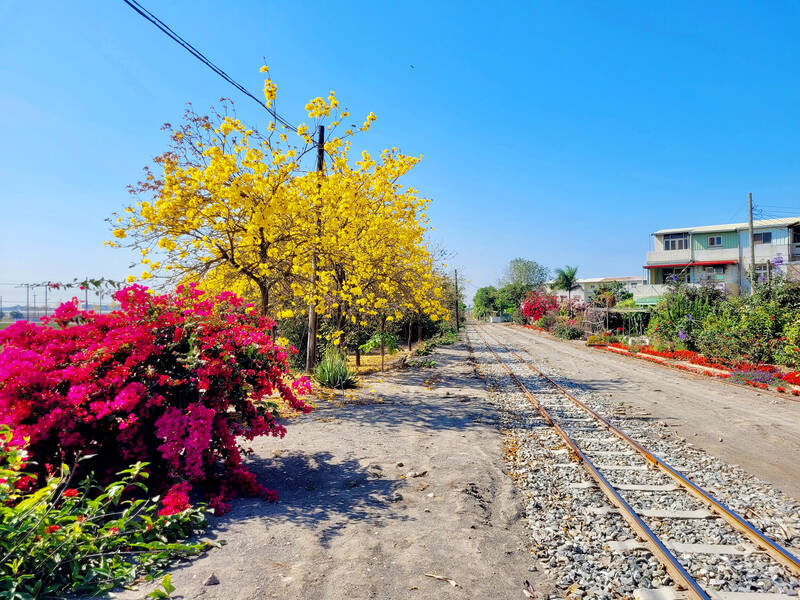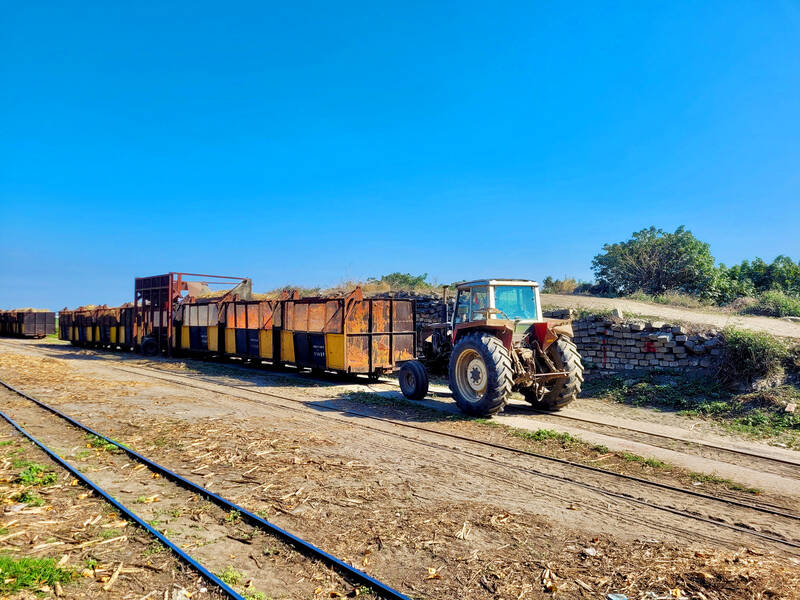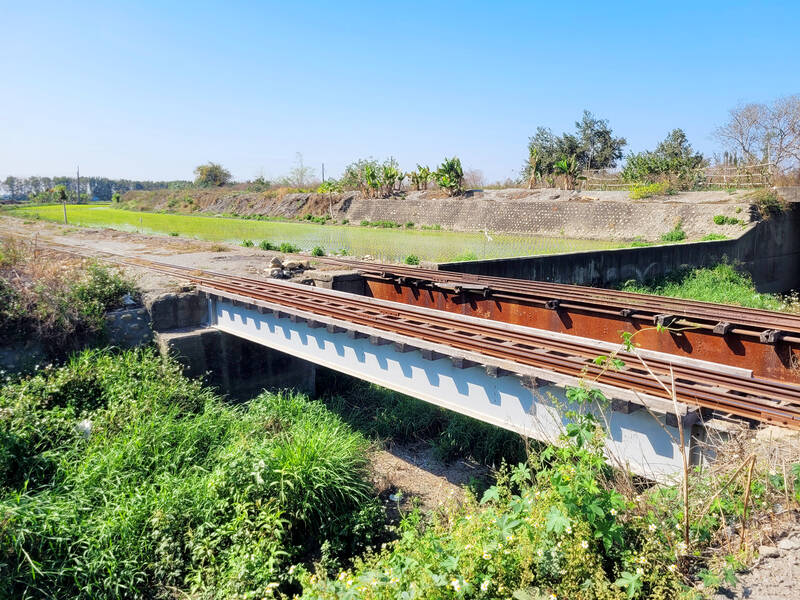“Is there still another train today?” I asked an older man with a deeply tanned and wrinkled face sitting in a makeshift shelter near the narrow train tracks, hoping he would at least respond in Mandarin and not Hoklo. Out here in rural Yunlin County, the latter seemed more likely. Thankfully, he did respond in Mandarin, but I still didn’t understand all of it.
“Yes, there’s still one more. This is [something I couldn’t understand] nine, and then there’s 10, 11, 12 and 13 over there, and that’s it,” he said, pointing further to the west, away from the center of Huwei Township (虎尾) and its sugar factory. I thanked him for his help and considered my plan of action for the rest of the afternoon.
As the only narrow-gauge railway still being used to transport sugarcane in Taiwan, this line offers a unique glimpse into the recent past, when Taiwan’s economy was heavily bolstered by sugar exports and road traffic was regularly stopped by trains hauling the season’s sugarcane harvest to the factory for pressing. The harvest here now lasts from December to March, and I had timed my visit to Huwei appropriately to see the curious sight of sugarcane-laden train cars stopping traffic in downtown Huwei.

Photo by Tyler Cottenie
As this is not a passenger train, there is no schedule posted so knowing when to show up to see the train in action is a bit of a guessing game. I asked a crossing guard in the Huwei town center when I arrived and he told me it wouldn’t come for another two hours, so I decided to follow the tracks out of town until I found the train, so I could watch it being loaded in the field. There was not always a road right beside the tracks, so I had to take several detours away from the tracks and back again further west. Every time the tracks left my sight, I wondered if I’d miss the train going by, which is how I ended up at a random crossing asking a local for the train’s whereabouts.
LOADING UP THE TRAINS
I had initially stopped at this particular road crossing not to ask about the train, but because I had noticed several train cars sitting on the tracks fully loaded with sugarcane, but without a locomotive. Beside them was a large hopper and a manmade mound of dirt. Trucks can drive up the mound and empty their loads into the hopper, which funnels the contents into the train car below. I had seen this same thing before on the tourist sugar train ride at the Suantou Sugar Factory near the Chiayi High Speed Rail, but that one was clean and bare, while this one was clearly still in active use.

Photo by Tyler Cottenie
I decided I had enough time to keep hunting down the train, so I continued my zigzagging journey westward, following the angle of the rail line as closely as the straight north-south or east-west farm roads would allow. Finally, at a road crossing about 10km west of the Huwei Sugar Factory, I saw some action. Dust rose into the air above a set of train cars out in a field while a worker stood nearby supervising. A tractor was on the tracks, apparently to position the train cars for loading.
I looked on my phone and discovered that this place was actually on Google Maps, and labeled as Loading Station Number 10 (10番裝車場 ). Now I finally understood what the helpful man in the shelter had been telling me. The word I couldn’t understand (番, pronounced fan in Mandarin) simply means “Number” when indicating an item from a sequence, both in Japanese and in Hoklo, and this usage can likely be traced back to the sugar factory’s early days in the Japanese era.
The man I’d talked to had simply been telling me we were at “Number 9.” The train was now getting loaded at Loading Station Number 10. Number 11 is visible but unlabeled on Google Maps, while Numbers 12 and 13, several kilometers west, are again labeled. Contrary to my intuition, the sugarcane is not loaded directly into train cars from the ends of rows in the field as it is harvested, but is directed to one of these central loading stations for loading through the hopper. As the harvest draws to a close this month, anyone wanting to see the loading process may have to make their way out to one of these more distant loading stations as the last of the fields get cleaned up.

Photo by Tyler Cottenie
TO THE FACTORY
I started making my way back to the town center to watch the train passing through and noticed that a lot of improvements have been made next to the tracks as the place continues to draw tourists. In one area, a brand new pedestrian sidewalk and separate paved scooter lane have been created, and the former chaotic mess of personal gardens and rusty, weed-choked makeshift fences now has a more manicured appearance. This stretch of track, between Beiping Road and Fusing Road, would be a great place to watch the train as it passes right along a row of houses that abut the narrow-gauge tracks.
Every crossing in town is manned, even though there are automatic arms that come down to stop traffic when the train arrives. This is perhaps not only to prevent intrusions into the crossing when the train is passing through, but also to keep an eye out for locals accidentally blocking the tracks in between trains; for most of the year, the railroad is not in service and people drive and park right on it. Even when the train is in service, it’s possible to enter the area adjacent to the tracks on foot or by scooter via one of the railroad crossings. It’s a bit chaotic, even for Taiwan.
I arrived at my chosen intersection to wait for the train’s crossing and just after 3:30pm, the crossing guards got up off their chairs, the bells started ringing, the crossing arms came down, and Taisugar’s diesel locomotive #118 tooted its horn as it pulled upwards of 60 cars loaded with sugarcane across Jhongjheng Road (中正路) in Huwei. It was a surprising amount, considering that this was the second trainload of the day, and that this process goes on for nearly four months.
In retrospect, probably the best place to observe the train would be at Houbiliaoqi Station (後壁寮旗站), just west of town where the Jiuhuwei River makes a 120-degree turn. There are colorful trees and an old station building at this crossing. For those wanting to explore the rail line or hunt down the train in the fields, a scooter is the easiest option, but a ride through the countryside on a bicycle would be even more enjoyable. Simply type “Sugar Factory” in Google Maps near Huwei and Loading Stations 9, 10, 12 and 13 will show up. Arrive early in the morning or early in the afternoon to have the best chance of seeing the train on its way both out and back. Harvest is set to end sometime this month, so don’t delay.
GETTING THERE:
From Yunlin HSR, take bus 7112, 7101, 7103 or 7104 to Huwei. From TRC Dounan, take bus 7701 or 7102 to Huwei. From TRC Douliu, take bus 7122, 7123, or 7124 to Huwei. Scooter rentals are available at Douliu.

On April 26, The Lancet published a letter from two doctors at Taichung-based China Medical University Hospital (CMUH) warning that “Taiwan’s Health Care System is on the Brink of Collapse.” The authors said that “Years of policy inaction and mismanagement of resources have led to the National Health Insurance system operating under unsustainable conditions.” The pushback was immediate. Errors in the paper were quickly identified and publicized, to discredit the authors (the hospital apologized). CNA reported that CMUH said the letter described Taiwan in 2021 as having 62 nurses per 10,000 people, when the correct number was 78 nurses per 10,000

As we live longer, our risk of cognitive impairment is increasing. How can we delay the onset of symptoms? Do we have to give up every indulgence or can small changes make a difference? We asked neurologists for tips on how to keep our brains healthy for life. TAKE CARE OF YOUR HEALTH “All of the sensible things that apply to bodily health apply to brain health,” says Suzanne O’Sullivan, a consultant in neurology at the National Hospital for Neurology and Neurosurgery in London, and the author of The Age of Diagnosis. “When you’re 20, you can get away with absolute

May 5 to May 11 What started out as friction between Taiwanese students at Taichung First High School and a Japanese head cook escalated dramatically over the first two weeks of May 1927. It began on April 30 when the cook’s wife knew that lotus starch used in that night’s dinner had rat feces in it, but failed to inform staff until the meal was already prepared. The students believed that her silence was intentional, and filed a complaint. The school’s Japanese administrators sided with the cook’s family, dismissing the students as troublemakers and clamping down on their freedoms — with

As Donald Trump’s executive order in March led to the shuttering of Voice of America (VOA) — the global broadcaster whose roots date back to the fight against Nazi propaganda — he quickly attracted support from figures not used to aligning themselves with any US administration. Trump had ordered the US Agency for Global Media, the federal agency that funds VOA and other groups promoting independent journalism overseas, to be “eliminated to the maximum extent consistent with applicable law.” The decision suddenly halted programming in 49 languages to more than 425 million people. In Moscow, Margarita Simonyan, the hardline editor-in-chief of the